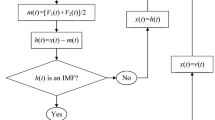Abstract
To solve the problem of difficulty in fault feature extraction for rolling bearings under strong noise conditions, a K-value calculation method of variational mode decomposition (VMD) based on singular value kurtosis difference spectrum is proposed, which is combined with the improved maximum correlation kurtosis deconvolution (MCKD) to achieve fault diagnosis. Firstly, the singular value decomposition (SVD) algorithm is used to denoise the strong noise rolling bearing fault signals, and then, the optimal number of decomposition layers is determined according to the center frequency distance between the singular value kurtosis spectrum and the decomposed intrinsic modal function (IMF). Filtering IMFs and reconstructing faulty signals by correlation and kurtosis criteria. Optimizing the filter length L and the number of shifts M of the MCKD using the dung beetle optimizer (DBO) to enhance the signal characteristics. Finally, the envelope spectrum is used to extract the eigenfrequencies for fault diagnosis of rolling bearings and to determine the fault location. Experimentally, it is shown that the method can effectively extract the fault characteristics of rolling bearings and carry out fault diagnosis under strong noise interference.













Similar content being viewed by others
Data availability
The datasets generated during and/or analyzed during the current study are available from the corresponding author on reasonable request.
References
Zhang, J., Zhang, Q., Qin, X., et al.: A two-stage fault diagnosis methodology for rotating machinery combining optimized support vector data description and optimized support vector machine. Measurement 200, 111651 (2022)
Qian, M., Yu, Y., Guo, L., et al.: A new health indicator for rolling bearings based on impulsiveness and periodicity of signals. Meas. Sci. Technol. 33(10), 105008 (2022)
Yang, J., Zhou, C.: A fault feature extraction method based on LMD and wavelet packet denoising. Coatings 12(2), 156 (2022)
Han, D., Zhao, N., Shi, P.: Gear fault feature extraction and diagnosis method under different load excitation based on EMD, PSO-SVM, and fractal box dimension. J. Mech. Sci. Technol. 33, 487–494 (2019)
Li, H., Liu, T., Wu, X., et al.: Application of EEMD and improved frequency band entropy in bearing fault feature extraction. ISA Trans. 88, 170–185 (2019)
Wang, L., Shao, Y.: Fault feature extraction of rotating machinery using a reweighted complete ensemble empirical mode decomposition with adaptive noise and demodulation analysis. Mech. Syst. Signal Process. 138, 106545 (2020)
Zhang, X., Miao, Q., Zhang, H., et al.: A parameter-adaptive VMD method based on grasshopper optimization algorithm to analyze vibration signals from rotating machinery. Mech. Syst. Signal Process. 108, 58–72 (2018)
Xing, Y.H., Yu, H., Zhang, J., et al.: Research on the O-VMD thickness measurement data processing method based on particle swarm optimization[J/OL]. Chin. J. Sci. Instrum. 1–11[2023-06-03].
Ji, Z.Y., Tang, Q., Li, Y.X., et al.: Power system harmonic analysis under non-stationary situations based on AVMD and improved energy operator. Chin. J. Sci. Instrum. 43(07), 209–217 (2022)
Tan, C., Yang, L., Chen, H., et al.: Fault diagnosis method for rolling bearing based on VMD and improved SVM optimized by METLBO. J. Mech. Sci. Technol. 36(10), 4979–4991 (2022)
Miao, Y., Zhao, M., Lin, J., et al.: Application of an improved maximum correlated kurtosis deconvolution method for fault diagnosis of rolling element bearings. Mech. Syst. Signal Process. 92, 173–195 (2017)
McDonald, G.L., Zhao, Q., Zuo, M.J.: Maximum correlated Kurtosis deconvolution and application on gear tooth chip fault detection. Mech. Syst. Signal Process. 33, 237–255 (2012)
Hong, L., Dhupia, J.S.: A time domain approach to diagnose gearbox fault based on measured vibration signals. J. Sound Vib. 333(7), 2164–2180 (2014)
Zhu, X.Y., Wang, Y.J.: Early fault diagnosis of rolling bearings based on autocorrelation analysis and MCKD. J. Vib. Shock 38(24), 183–188 (2019)
Chen, X., Guo, Y., Wu, X., et al.: Planet bearing outer-race fault diagnosis based on MCKD and improved IESFO gram. J. Vib. Shock 40(20), 200–206 (2021)
He, Y., Wang, H., Xue, H., et al.: Research on unknown fault diagnosis of rolling bearings based on parameter-adaptive maximum correlation kurtosis deconvolution. Rev. Sci. Instrum. 92(5), 055103 (2021)
Faris, H., Aljarah, I., Al-Betar, M.A., et al.: Grey wolf optimizer: a review of recent variants and applications. Neural Comput. Appl. 30, 413–435 (2018)
Xue, J., Shen, B.: A novel swarm intelligence optimization approach: sparrow search algorithm. Syst. Sci. Control Eng. 8(1), 22–34 (2020)
Xue, J., Shen, B.: Dung beetle optimizer: a new meta-heuristic algorithm for global optimization. J. Supercomput. 79(7), 7305–7336 (2023)
Jun, Z.: Diagnosis of multiple faults in rolling bearings based on adaptive maximum correlated kurtosis deconvolution. J. Vib. Shock 38(22), 171–177 (2019)
Song, Y.B., Liu, Y.H., Zhu, D.P.: Adaptive UPEMD-MCKD rolling bearing fault feature extraction method. J. Vib. Shock 42(03), 83–91 (2023)
Liu, P., Lin, Z., Zhang, M., et al.: Fault diagnosis of rolling bearing based on permutation entropy optimized maximum correlation kurtosis deconvolution. IOP Conf. Ser. Mater. Sci. Eng. 1043(2), 022029 (2021)
Funding
This research was funded by the National Natural Science Foundation of China (62203146).
Author information
Authors and Affiliations
Contributions
ML is responsible for the entire experiment execution and paper writing. DL is responsible for the review and correction of papers. LY and XW are responsible for guiding the experiment. FZ and YL are responsible for checking and reviewing manuscripts. This study is funded by LY.
Corresponding author
Ethics declarations
Competing interests
The authors have no relevant financial or non-financial interests to disclose.
Additional information
Publisher's Note
Springer Nature remains neutral with regard to jurisdictional claims in published maps and institutional affiliations.
Rights and permissions
Springer Nature or its licensor (e.g. a society or other partner) holds exclusive rights to this article under a publishing agreement with the author(s) or other rightsholder(s); author self-archiving of the accepted manuscript version of this article is solely governed by the terms of such publishing agreement and applicable law.
About this article
Cite this article
Li, D., Li, M., Yang, L. et al. Rolling bearing fault diagnosis in strong noise background based on vibration signals. SIViP 18, 1295–1303 (2024). https://doi.org/10.1007/s11760-023-02846-y
Received:
Revised:
Accepted:
Published:
Issue Date:
DOI: https://doi.org/10.1007/s11760-023-02846-y



